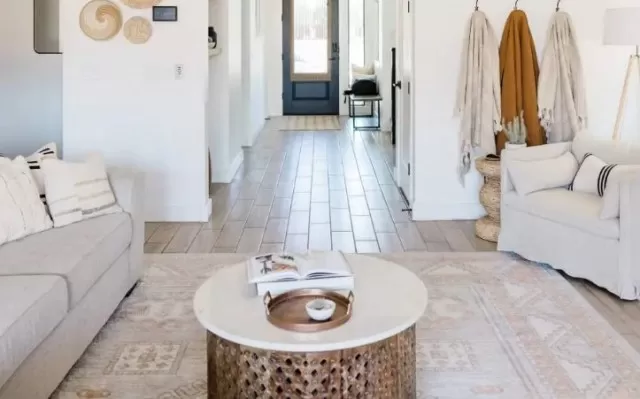While it may initially give the impression of an organized home, hiding clutter behind closed cabinet doors is not a sustainable household solution.
Storage spaces that are filled with random kitchen utensils, unused toys, and almost-empty products can quickly become overwhelming.
While it may seem convenient to tuck these items away in drawers, the “out of sight, out of mind” approach is not always the most effective when it comes to decluttering your house.
One of the main culprits of clutter is having an excess of the same items or holding onto things that are no longer usable or needed.
This is an opportunity to donate unused items and responsibly recycle what you can, lightening the burden of clutter. While finding the perfect moment for a complete decluttering overhaul can be challenging, following this checklist of 14 items to gradually pare down can help you slowly and steadily reorganize your home.
What can clutter cause?

Clutter can have various negative effects on our mental well-being and cognitive functioning.
Our brains naturally seek order and organization, so when we are surrounded by clutter, it creates visual chaos that can drain our cognitive resources. The constant presence of disorganization can be mentally exhausting and make it difficult for us to concentrate and focus on the tasks at hand.
The visual distraction caused by clutter can lead to cognitive overload, overwhelming our brains with excessive stimuli.
This can make it challenging to process information efficiently, remember important details, and make clear decisions. Clutter can also contribute to a sense of mental clutter and stress, as it creates a constant reminder of unfinished tasks or a lack of order in our surroundings.
Furthermore, a cluttered environment can hinder creativity and productivity.
It can be challenging to think clearly and generate new ideas when our physical space is cluttered and cluttered thoughts occupy our minds.
To combat the negative effects of clutter, it’s important to establish and maintain an organized living and working environment.
Regular decluttering and organizing sessions can help create a sense of calm and promote mental clarity. By reducing visual distractions and creating a more ordered space, we can enhance our cognitive functioning, improve focus, and restore a sense of tranquility to our minds.
Clutter-Causing Household Items You Should Eliminate

By taking small steps over time, you can create a more organized and clutter-free living environment.
Unmatched Utensils.
If your utensil drawer is overflowing with a jumble of forks, spoons, and knives, it’s time to declutter and organize your cutlery.
Instead of cramming multiple sets into the same drawer, take a moment to assess how many utensils you need. Typically, having around 8 to 12 of each type is sufficient, but it can vary based on your household size and entertaining frequency.
Consider your daily usage and donate any excess utensils that are no longer needed.
Books.
Whether you’re an avid reader or have accumulated books over time, it’s common to have overflowing bookshelves.
Take the opportunity to go through your collection and keep only your favorite books and those you genuinely plan to read. Donate the remaining books to your local library, thrift store, or book buyback programs.
You can also check if your school district accepts book donations.
Plastic Food Containers.
If you struggle to find matching lids for your plastic food containers, it’s a sign that you have too many.
Empty your entire cabinet, pair up lids with their corresponding bottoms, and recycle any loose or unmatched pieces. Dispose of warped and stained containers, and consider donating those that are rarely used.
Glassware.
From vases to cups, glassware can quickly clutter up your space.
While it may be tempting to have a variety of glasses for different drinks and occasions, most of them end up collecting dust. Sort through your glassware collection and keep coordinating sets together.
Donate any random or unused pieces, including stemware and flower vases that haven’t been used in years.
Nearly Empty Products.
We often accumulate almost-empty products in various areas of our homes, whether it’s cosmetics or cleaning supplies.
Take the time to search your kitchen and bathroom cabinets for these items that have been forgotten. Check expiration dates and discard any expired products.
Prioritize using up the viable supplies before opening new ones. If you have unopened items that you haven’t used in years or multiples of the same product, consider donating them to local charities or shelters.
Old Clothes.
Closets tend to be cluttered magnets, especially with old clothes that no longer fit or are rarely worn.
Take a critical look at your wardrobe and let go of garments that no longer serve you. Donate gently used clothes that are still in good condition and consider keeping duplicates to a minimum.
Organize your remaining clothes to free up valuable space.
Sports Equipment.
Garages often become overwhelmed with excess sports equipment.
Assess your athletic gear and keep items that are regularly used, while donating the old ones that are still in working order. Determine how many of each item you truly need and get rid of the rest.
Group similar items together and utilize wall space to hang racquets and bats.

Toys.
Children’s rooms can easily become cluttered with an abundance of toys.
Declutter and donate toys that are no longer played with to organizations in need. Establish an organizational system, such as using dressers and shelves, to keep the remaining toys manageable and free of clutter.
Water Bottles.
Storing water bottles can be a challenge due to their height.
You likely only need one water bottle per family member, so donate any extras. Use a magazine holder to stack the remaining water bottles and keep them neatly organized.
Outdated Cords and Chargers.
Most homes have a drawer filled with tangled and unnecessary cords and chargers.
Dispose of chargers that no longer work and purge cords that you can’t identify. Bundle up the remaining cords and chargers with rubber bands or ties for better organization.
Mail and Paper Items.
Tackle the never-ending mail pile by sorting through it immediately.
Shred unnecessary items and recycle junk mail to prevent clutter from building up. Use labeled storage containers or baskets for important mail and regularly go through expired papers to keep the pile under control.
Condiments.
Having an excess of condiments can quickly clutter up your fridge.
Assess your collection and keep only one of each type of condiment. Dispose of expired items and use up any duplicates.
Before grocery shopping, evaluate your condiment section to avoid buying unnecessary multiples.
Winter Gear.
Winter accessories like hats, gloves, and scarves tend to accumulate, often with duplicates taking up space.
Keep only your favorite and warmest items and donate the rest to shelters or thrift stores.
Small kitchen appliances.
small kitchen appliances, while useful, can take up valuable counter and cabinet space.
Identify the appliances you use frequently and designate a specific storage area for them. Donate any extra appliances and keep only one of each type.
By decluttering and organizing these common household items, you can create a more streamlined and clutter-free living space.
*The information is for reference only.